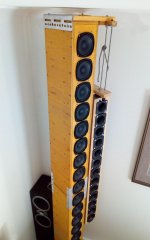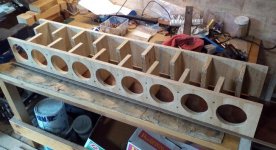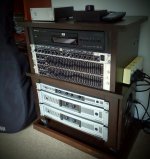FRS7
Thank you for the comments.
Would you have any suggestions or could you guide me to what volume enclosure to use and would it be more advantageous to build individual sealed areas for each driver In column or open area in whole column then seal back
OR
With this driver it makes no difference.
I have already constructed two of Martinson’s THAM6 subs for the bottom end, which work surprisingly well. As for the crossover I’ll be using the mini-dsp. My plan is to cross them around 300 Hz, I’m not certain the THAM6’s will be ideal, so will hear how good,bad,or neither later. I do have some 8” BR I could use in a pinch.
Thank you for the comments.
Would you have any suggestions or could you guide me to what volume enclosure to use and would it be more advantageous to build individual sealed areas for each driver In column or open area in whole column then seal back
OR
With this driver it makes no difference.
I have already constructed two of Martinson’s THAM6 subs for the bottom end, which work surprisingly well. As for the crossover I’ll be using the mini-dsp. My plan is to cross them around 300 Hz, I’m not certain the THAM6’s will be ideal, so will hear how good,bad,or neither later. I do have some 8” BR I could use in a pinch.
Having done a box sim, I see why you got conflicting advice on that driver. Its high Q so it has pretty much the same response independent of box size, from 100L for 25 drivers up to infinity or no box. So you could use it for OB. You get a peaked response so EQ is required. It does not seem suitable for bass reflex.
I'd again advise crossing over to woofer circa 200 Hz even though SPL wise you could use it down to 100 Hz. Below 200 Hz group delay rises sharply. No need for individual sealed chambers but box should be well braced...
we should limit discussion in this thread as its way off topic
I'd again advise crossing over to woofer circa 200 Hz even though SPL wise you could use it down to 100 Hz. Below 200 Hz group delay rises sharply. No need for individual sealed chambers but box should be well braced...
we should limit discussion in this thread as its way off topic
Hi all and Jim!
I feel compelled to join this forum, as I have just completed a system with arrays. I have followed the rules and advice set out by Jim in his ‘white paper’ and read also about Roger Russell IDS-25 and his work with McIntosh.
I have also read a lot of pros like the dynamics, the wide soundstage; and cons, like the comb filtering, the lack of lows, the cost. I had to find out for myself, and this is the result below.
The main arrays go from floor to ceiling, are made of heavily braced 16mm plywood and use 18 GRS 4FR-8 full-range 4-1/2". The tweeter arrays are 1.2m long, use 12 (similar to) GRS BT2-8 3-3/8" Horn Loaded Bullet Tweeter and are suspended from the top of the main arrays for alignment and uncoupling.
The subwoofers use 4 7” drivers each.
It looks rough but the whole thing is concealed behind a light curtain.
To run all that I have: DVD player as transport, DAC, pot, EQ if necessary, 3-way electronic crossover, and plenty of cheap watts: 2x250W lows, 2x500W main, 2x60W treble.
The cutoff frequencies are currently: 90Hz and 4500Hz, giving ranges of about 2, 5.5 and 2 octaves.
I have tried using the main arrays as full range, and it’s not bad but some EQ is needed in the highs. A subwoofer is necessary below 100Hz.
I am very happy with the result, and as Jim says (Roger Russell too), the comb filtering is negligible/inaudible from the listening area.
For the whole system I have spent slightly less than 2000 Aussie dollars (USD1600).
Very Happy (needs to be said twice!).
And thanks, Jim!
I feel compelled to join this forum, as I have just completed a system with arrays. I have followed the rules and advice set out by Jim in his ‘white paper’ and read also about Roger Russell IDS-25 and his work with McIntosh.
I have also read a lot of pros like the dynamics, the wide soundstage; and cons, like the comb filtering, the lack of lows, the cost. I had to find out for myself, and this is the result below.
The main arrays go from floor to ceiling, are made of heavily braced 16mm plywood and use 18 GRS 4FR-8 full-range 4-1/2". The tweeter arrays are 1.2m long, use 12 (similar to) GRS BT2-8 3-3/8" Horn Loaded Bullet Tweeter and are suspended from the top of the main arrays for alignment and uncoupling.
The subwoofers use 4 7” drivers each.
It looks rough but the whole thing is concealed behind a light curtain.
To run all that I have: DVD player as transport, DAC, pot, EQ if necessary, 3-way electronic crossover, and plenty of cheap watts: 2x250W lows, 2x500W main, 2x60W treble.
The cutoff frequencies are currently: 90Hz and 4500Hz, giving ranges of about 2, 5.5 and 2 octaves.
I have tried using the main arrays as full range, and it’s not bad but some EQ is needed in the highs. A subwoofer is necessary below 100Hz.
I am very happy with the result, and as Jim says (Roger Russell too), the comb filtering is negligible/inaudible from the listening area.
For the whole system I have spent slightly less than 2000 Aussie dollars (USD1600).
Very Happy (needs to be said twice!).
And thanks, Jim!
Attachments
Update on My Modified CBT24 Project
It been a while since I made updates on my Modified CBT24 project that started this thread way back when. The major changes have been fresh electronics over the past two years but no changes to the towers that contain the 24 drivers.
The HT receiver that powers the towers was changed to the Denon AVR-X3600H. The Denon receiver is an improvement in every way to my Marantz NR1600 that I had for some 10 years. The AVR-X3600H is a 105 watts RMS 9.2
receiver which is good down to 4 ohms impedance for each receiver channel. It also includes Audyssey MultEQ XT32 room correction capability. You can read the Crutchfield review for a summary of the 3600's features and reviews at:
Denon AVR-X3600H (2019 model) 9.2-channel home theater receiver with Wi-Fi(R), Bluetooth(R), Apple(R) AirPlay(R) 2, and Amazon Alexa compatibility at Crutchfield
I'm using my Denon AVR-X3600H as just a 2.2 channel setup which sounds like far less capability than a 9.2 channel receiver provides. But I'm getting the internal crossover between the subs and towers (at 125 Hz) plus the Audyssey MultEQ XT32 capability to provide equalization across the spectrum.
For subwoofers I decided to marry 2 SVS SB-1000 powered units to replace my home brew of either passive but powered DIY subwoofers or active DIY subs that I used previously. While I'm not turning in my DIY speaker builder card just yet, the two little SVS units are impressive. The SVSs are sealed 12 inch drivers integrated with a 300 watts RMS amp in each box.
The setup is perfect in the living room and permits me to crank the sound for tight bass. Yet the wife has her own listening level that pleases her taste.
It been a while since I made updates on my Modified CBT24 project that started this thread way back when. The major changes have been fresh electronics over the past two years but no changes to the towers that contain the 24 drivers.
The HT receiver that powers the towers was changed to the Denon AVR-X3600H. The Denon receiver is an improvement in every way to my Marantz NR1600 that I had for some 10 years. The AVR-X3600H is a 105 watts RMS 9.2
receiver which is good down to 4 ohms impedance for each receiver channel. It also includes Audyssey MultEQ XT32 room correction capability. You can read the Crutchfield review for a summary of the 3600's features and reviews at:
Denon AVR-X3600H (2019 model) 9.2-channel home theater receiver with Wi-Fi(R), Bluetooth(R), Apple(R) AirPlay(R) 2, and Amazon Alexa compatibility at Crutchfield
I'm using my Denon AVR-X3600H as just a 2.2 channel setup which sounds like far less capability than a 9.2 channel receiver provides. But I'm getting the internal crossover between the subs and towers (at 125 Hz) plus the Audyssey MultEQ XT32 capability to provide equalization across the spectrum.
For subwoofers I decided to marry 2 SVS SB-1000 powered units to replace my home brew of either passive but powered DIY subwoofers or active DIY subs that I used previously. While I'm not turning in my DIY speaker builder card just yet, the two little SVS units are impressive. The SVSs are sealed 12 inch drivers integrated with a 300 watts RMS amp in each box.
The setup is perfect in the living room and permits me to crank the sound for tight bass. Yet the wife has her own listening level that pleases her taste.
Last edited:
FYI, if you're interested, I threw together a CBT of waveguides here:
Line array prototype (with waveguide and CBT shading)
Line array prototype (with waveguide and CBT shading)
Hank,
The Dayton 4" PS95-8 driver that you mentioned is 'huge' compared to the SB Acoustics 2.5" SB65s. We are talking 98.2 mm (3.866"round frame) vs. the 64 mm (2.519") square frames of the SB65. So we have a 34.2 mm or about 1.346" width dimension difference per driver. Hence, the 24 driver array width the same spacing of my project would be 32.3" longer. The SB65s have a total array baffle length (stretched out) of 65" or the same as Don Keele's Epique version. Hence, larger size drivers would significantly lengthen the array and likely harm the high frequency performance as the c-t-c spacing of the drivers increase by that 34.2 mm value.
More promising in matching the scale of the Epique or my modified CBT24 arrays is to start with a 2 to 2.5" dimension driver sizing and go from there. Some possible drivers from the Parts Express line include the
Dayton Audio ND64-16 2-1/2" Aluminum Magnesium Cone Full-Range Neo Driver 16 Ohm
which is a 16 ohms unit similar to the Epique's 16 ohms unit (may be the same driver). Several other drivers come close to the sizing for the scale of the CBT24s arrays. You can review the various other drivers among the 20 or so in the 2.5" size in P-E's offerings for fit checks.
Another new driver in the P-E line is the Eminence Alpha 2-8 which is a nominal 2" driver
Eminence Alpha 2-8 2" Full-Range Speaker 4 Pack. Another 2" driver is the Fountek FR58EX 2" Neodymium Full Range Speaker Driver
Some of these other drivers may need vented enclosures to lower the cross over to your preferences but that should be doable. Having good driver drawings is key to judge between each unit. Again I can not make expert recommendations on drivers without a lot of comparisons, even testing, and adding your constraints.
On the shading networks for the CBT24 arrays: Don provided me the shading network for his 16 ohms driver version and I scaled it to 4 ohms driver for my arrays. 8 ohms driver shading will take some thinking to achieve the proper weights but that is mathematics.
Going with Kelvin is an easy choice given his ability to derive a CNC'ed array for these small drivers.
Jim
FYI -
I just ran a full set of measurements of my ND64-16s, including VAS, and have basically confirmed that the Parts Express specs here are accurate:
https://www.parts-express.com/pedoc...ium-cone-full-range-driver-specifications.pdf
I was going to post my results, but they're so close to PE, it's probably not worth the trouble.
Very nice midrange for $16
hello I am in the process of preparing for a build in about a years time. In your post you mention adding two absorption panels on each side wall. Am I correct in thinking you are referring to the side walls of the curved array cabinet? Thanks.It's easy though to get sharp pin pointing with CBTs too if that's a desire. You simply add two absorption panels on each side walls. No vertical treatment is really needed. The benefit of ceiling treatment is mainly below the schroeder frequency.
Absorption panels should be at reflection points of each speaker. You can also consider to absorp (or diffuse) the opposite side wall, depending on the distance.

You'll find them with a mirror (mirror image of the speaker at ear height).

Ideally treatment should be broadband, meaning highly effective down to the Schroeder frequency. With traditional absorbers this requires 5" (15 cm) depth. Or RPG sells Broadsorbor which absorps lower in frequency with less depth and you get away with 3" thickness with quite equal result.
You should considering treating the rear wall as well. Type of better treatment will depend on distance.

You'll find them with a mirror (mirror image of the speaker at ear height).
Ideally treatment should be broadband, meaning highly effective down to the Schroeder frequency. With traditional absorbers this requires 5" (15 cm) depth. Or RPG sells Broadsorbor which absorps lower in frequency with less depth and you get away with 3" thickness with quite equal result.
You should considering treating the rear wall as well. Type of better treatment will depend on distance.
@Jim Griffin; I’m assuming you are still enjoying your CBTs ? As someone who has a lot of line array experience, do you think the theoretical superiority of a CBT vs a vertical full height line array translates into the real world ? I guess I’m asking you, if you were only ever going to make one line array system, which one would it be based purely on sound quality?
Studley,
I've enjoyed my Modified CBT24 arrays for now 5 years. They are my favorite speakers in my more then 20 years of study and building line arrays. CBTs alleviate several issues associated with straight line arrays such as comb lines while providing nearly uniform vertical dispersion without lobing. My 5 feet tall CBTs excel for sitting and standing (I stand 6"3") listening without height limitations. The coverage in my listening room is nearly constant in volume and directivity throughout the area as I have mentioned before in this thread.
While others might question the performance of a full range CBT in the upper frequency ranges, I'm pleased with the sound quality for my listening.
Bottom line: Highly recommended.
Jim
I've enjoyed my Modified CBT24 arrays for now 5 years. They are my favorite speakers in my more then 20 years of study and building line arrays. CBTs alleviate several issues associated with straight line arrays such as comb lines while providing nearly uniform vertical dispersion without lobing. My 5 feet tall CBTs excel for sitting and standing (I stand 6"3") listening without height limitations. The coverage in my listening room is nearly constant in volume and directivity throughout the area as I have mentioned before in this thread.
While others might question the performance of a full range CBT in the upper frequency ranges, I'm pleased with the sound quality for my listening.
Bottom line: Highly recommended.
Jim
Last edited:
- Home
- Loudspeakers
- Full Range
- My New Line Array--It's a Modified CBT24


